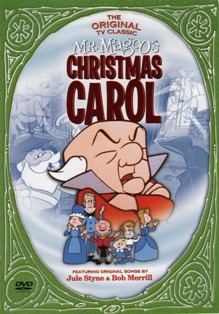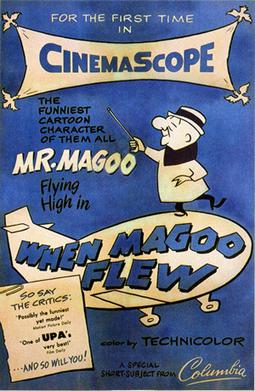
Aladdin is a 1992 American animated musical fantasy comedy film produced by Walt Disney Feature Animation and released by Walt Disney Pictures. It is based on the Arabic folktale "Aladdin" from the One Thousand and One Nights. The film was produced and directed by John Musker and Ron Clements from a screenplay they cowrote with the writing team of Ted Elliott and Terry Rossio. Featuring the voices of Scott Weinger, Robin Williams, Linda Larkin, Jonathan Freeman, Frank Welker, Gilbert Gottfried, and Douglas Seale, the film follows the titular Aladdin, an Arabian street urchin, who finds a magic lamp containing a genie. With the genie's help, Aladdin disguises himself as a wealthy prince and tries to impress the Sultan of Agrabah in order to win the heart of his free-spirited daughter, Princess Jasmine, as the Sultan's evil vizier Jafar plots to steal the magic lamp for his own uses.

Gerald McBoing-Boing is an animated short film about a little boy who speaks through sound effects instead of spoken words. It was produced by United Productions of America (UPA) and given wide release by Columbia Pictures on November 2, 1950. It was adapted by Phil Eastman and Bill Scott from a story by Dr. Seuss, directed by Robert Cannon, and produced by John Hubley.

United Productions of America, better known as UPA, was an American animation studio and later distribution company founded in 1941 as Industrial Film and Poster Service by former Walt Disney Productions employees. Beginning with industrial and World War II training films, UPA eventually produced theatrical shorts for Columbia Pictures such as the Mr. Magoo series. In 1956, UPA produced a television series for CBS, The Boing-Boing Show, hosted by Gerald McBoing Boing. In the 1960s, UPA produced syndicated Mr. Magoo and Dick Tracy television series and other series and specials, including Mister Magoo's Christmas Carol. UPA also produced two animated features, 1001 Arabian Nights and Gay Purr-ee, and distributed Japanese films from Toho Studios in the 1970s and 1980s.

Mister Magoo's Christmas Carol is a 1962 animated musical holiday television special produced by UPA. It is an adaptation of Charles Dickens' 1843 novella A Christmas Carol, and it features UPA's character Mr. Magoo as Ebenezer Scrooge. The special first aired on December 18, 1962, on NBC and was the first animated Christmas special to be produced specifically for television.

Aladdin is a Middle-Eastern folk tale. It is one of the best-known tales associated with The Book of One Thousand and One Nights, despite not being part of the original text; it was added by the Frenchman Antoine Galland, based on a folk tale that he heard from the Syrian Maronite storyteller Hanna Diyab.
The Famous Adventures of Mr. Magoo is an American animated television series produced by United Productions of America that aired for one season on NBC from September 19, 1964 to April 24, 1965. The television series was based on the original cartoon of the same name, with Jim Backus reprising the voiceover of the role he did on TV: while doing this show, he continued with the prime time TV show Gilligan's Island. This was a follow-up to the original Mister Magoo series which aired from 1960-1961.

J. Quincy Magoo, better known as Mr. Magoo, is a fictional cartoon character created at the UPA animation studio in 1949. Voiced by Jim Backus, Mr. Magoo is an elderly, wealthy, short-statured retiree who gets into a series of comical situations as a result of his extreme near-sightedness, compounded by his stubborn refusal to admit the problem. However, through uncanny streaks of luck, the situation always seems to work itself out for him, leaving him no worse than before. Bystanders consequently tend to think that he is a lunatic, rather than just being near-sighted. In later cartoons, he is also an actor, and generally a competent one, except for his visual impairment.
Arabian Nights is a commonly used English title for One Thousand and One Nights, a Middle-Eastern folk tale collection.
Stephen Reginald Bosustow was a Canadian-born American film producer from 1943 until his retirement in 1979. He was one of the founders of United Productions of America (UPA) and produced nearly 600 cartoon and live-action shorts. He is chiefly remembered for producing a string of Mr. Magoo and Gerald McBoing-Boing cartoons in the 1950s, three of which earned Academy Awards. He is the only film producer in history who received all the Oscar nominations in one category (1956), guaranteeing him the winning Oscar. Magoo's Puddle Jumper was the eventual winner.
Abraham Levitow was an American animator who worked at Warner Bros. Cartoons, UPA and MGM Animation/Visual Arts. He is best known for his work under Chuck Jones' direction.

Aladdin and His Magic Lamp is a 1970 French animated film directed by Jean Image. It is loosely based on the Arabian Nights tale of Aladdin. Made by Image's fifty-artist crew on a limited schedule in 1969, the film proved successful with children upon its original release.

When Magoo Flew is a 1954 animated short produced by UPA for Columbia Pictures. Directed by Pete Burness and produced by Stephen Bosustow, When Magoo Flew won the 1955 Oscar for Short Subjects (Cartoons). In addition, it was the first UPA short to be made for the CinemaScope widescreen format. When Magoo Flew is also the title of a 2012 book by Adam Abraham on the history of the UPA studio.

A Thousand and One Nights is a 1945 tongue-in-cheek American adventure fantasy film set in the Baghdad of the One Thousand and One Nights, directed by Alfred E. Green and starring Evelyn Keyes, Phil Silvers, Adele Jergens and Cornel Wilde.
Henry Gahagen Saperstein was an American film producer and distributor.

Shirley Silvey was an American animator, whose credits included Mr. Magoo, The Rocky and Bullwinkle Show, Dudley Do-Right Show and George of the Jungle. Silvey was considered a pioneer in animation, as she was one of the first women to work in the field.
Magoo's Puddle Jumper is a 1956 animated short produced by UPA for Columbia Pictures. Directed by Pete Burness and produced by Stephen Bosustow, Magoo's Puddle Jumper won the 1957 Oscar for Short Subjects (Cartoons).
Wilson D. "Pete" Burness was an American animator and animation director. He was perhaps best known for his work on the Mr. Magoo series. He also contributed to the Tom and Jerry series, Looney Tunes, Merrie Melodies, and Rocky and His Friends.










